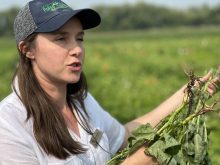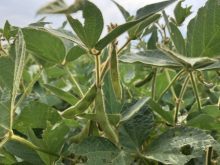Move over crab apples, chokecherries and saskatoons.
There are new fruit trees in town and they’re taking over yard space.
Traditional fruits remain popular but plant breeders have been working to develop others that appeal to the prairie palate and climate.
Dean and Sylvia Kreutzer are at the forefront of some of this work.
Their Over the Hill Orchards near Lumsden, Sask., is based on prairie sour cherries and they are branching out into other fruits.
Dean Kreutzer, a city boy and computer programmer who knew nothing about fruit production before the couple began their venture in 2000, works closely with re-searchers from the University of Saskatchewan to breed new varieties of fruits.
Read Also

Fusarium head blight mycotoxin detector in the works
A PhD student at the University of Saskatchewan has been working on developing a method of detecting fusarium damaged kernels to ease the struggles of producers, agronomists and industry.
Although he approaches fruit production from a commercial point of view, he has tips for those considering different fruit trees and shrubs for their yards.
Prairie-developed cherries are a well-established orchard crop now. Kreutzer said people who want to produce them in their own yards don’t need a green thumb.
The trees require little maintenance, grow just more than two metres high and the different varieties available now make fruit available throughout the season.
“There is a difference in when they ripen,” Kreutzer said. “You could have two trees, one that ripens at the beginning of August and the other in mid-August.”
Prairie cherries are typically tart and good for processing but some varieties are suitable to eat fresh. They are prolific.
“You can get 50, 60, 70 pounds of fruit off one bush,” he said.
Whatever variety you choose, Kreutzer recommends not picking the fruit too soon.
The longer the fruit hangs on the tree, the sweeter it becomes.
“You need one month after the cherries turn colour,” he advised.
The birds won’t wait to eat, however, so bird netting around the tree can protect the crop.
That’s easy enough to do with one or two trees. The Kreutzers have 3,500 trees, and 11 certified organic growers also have large orchards to supply Over the Hill.
Kreutzer said one of his growers lost about 2,000 pounds of fruit to robins and starlings.
“You have to be prepared to face the fact you’re going to lose some,” he said.
Apples
“Everybody should have an apple tree,” Kreutzer said.
By that he means everyone should plant a prairie variety of apple tree.
“Our apples are world-class. There is no reason to buy apples from the store.”
Apples have come a long way through plant breeding. The U of S has been breeding apples for about 90 years and is currently testing 40 selections with the help of 50 growers.
Newer varieties such as Prairie Sensation will last five to six months in a refrigerator crisper, Kreutzer said.
And they can be purchased on dwarf root stock, meaning a ladder won’t be required to pick the fruit.
Two to four trees will supply enough apples for a family.
More information on the varieties developed at U of S can be found at www.fruit.usask.ca.
Apricots
Yes, apricots can grow on the Prairies.
“Apricots are really hardy,” Kreutzer said. “They just bloom so early.”
Blossoms usually appear by May 1, making them subject to late frost.
Kreutzer said getting fruit once every four or five years makes them unreliable in terms of a steady supply.
However, there are other advantages to having an apricot tree in the yard. The blossoms produce an amazing fragrance and beautiful foliage that can be bright red, yellow and orange.
For now, apricots are still best planted for cosmetic reasons.
“Fruit is a bonus,” he said, unless one plans to run outside at midnight and cover the trees to protect them from frost.
However, Kreutzer is involved in breeding better apricots.
“That’s kind of my dream fruit,” he said.
He has about 200 trees in the ground and they include varieties from around the world. He collects the pollen and uses it to pollinate Canadian plants.
“You plant the seed and hope the genetic roulette mixes it up good,” Kreutzer said.
Apricots grown in Pakistan bloom later so that might be a good genetic cross, he said.
The breeding program is worth it, he added, because Canadian apricots taste “ridiculously good” compared to others.
Even California producers agree. On a tour here, they told Kreutzer his apricots were the best they had ever tasted.
That’s likely because California apricots are bred for size and quality but not necessarily for taste.
“Ours are small but good-tasting,” he said.
Grapes
“Grapes are one of the ones I’m most excited about” from a commercial perspective, said Kreutzer.
People have grown grapes in their yards for years but more breeding is underway by private growers and the university to improve all aspects of the vine and allow commercial production.
For the average rural resident, planting grapevines on the south side of a house to take advantage of the sun and giving them a bit of TLC should result in berries for grape juice and jelly, said Kreutzer.
Haskap
“This is a simple plant because you only need one,” he said. “They are self-fertile and you only need one to give you the berries.”
Cut the grapevine back in fall and it will climb back up a support trellis or structure the next spring.
Research at the U of S is looking at hybrid crosses using prairie varieties and good quality wine and table grapes.
“Personally, I’d like more seedless grapes for eating,” said Kreutzer.
Haskap breeding has been going on for several years across the Prairies. The oval-shaped blue fruit is tasty, but consistency and quality remain goals of breeders.
From a processing point of view, the fruit is fragile and not suitable for mechanical harvesting. But growers who want just a couple of shrubs should see success.
“Haskap is hardy as nails,” Kreutzer said. “There’s not much that can hurt it.”
The plant does need a pollinator; more than one shrub is needed for fruit production.
Some older yards may contain haskap, or blue honeysuckle, shrubs that came from Russia in early plantings. The fruit on those trees is probably best left for the birds.
However, the new crosses from Russian, Japanese and wild Canadian stock are flavourful.
Another advantage to haskap is early ripening. The earliest varieties can ripen ahead of strawberries, while others fruit later in summer.
Other fruits
Peaches are considered a delicate fruit for good reason.
“If I ever have a peach in the next 30 years that will survive the winter, I will be pretty happy,” said Kreutzer. “That’s the first step.”
In November, he moved indoors 50 peaches he had been growing in pots. Ten of them had already been damaged by a cold night earlier in the month.
Hardiness in peaches is more complicated than enduring cold temperatures. The trees are also affected by the freezing and thawing that can occur in regions that get chinooks.
At this point, peaches are not an option for prairie planters.
Kreutzer’s attempt at growing kiwis from Siberia didn’t do well, but two in a Regina backyard are flourishing, he said.
These kiwis are very small, with no fuzz. Anyone considering planting them requires a male and a female plant.
They need protection through the winter and seem to do best in indirect sun.
Other fruits that people are trying on the Prairies include goji berries, pears and hazelnuts.
















